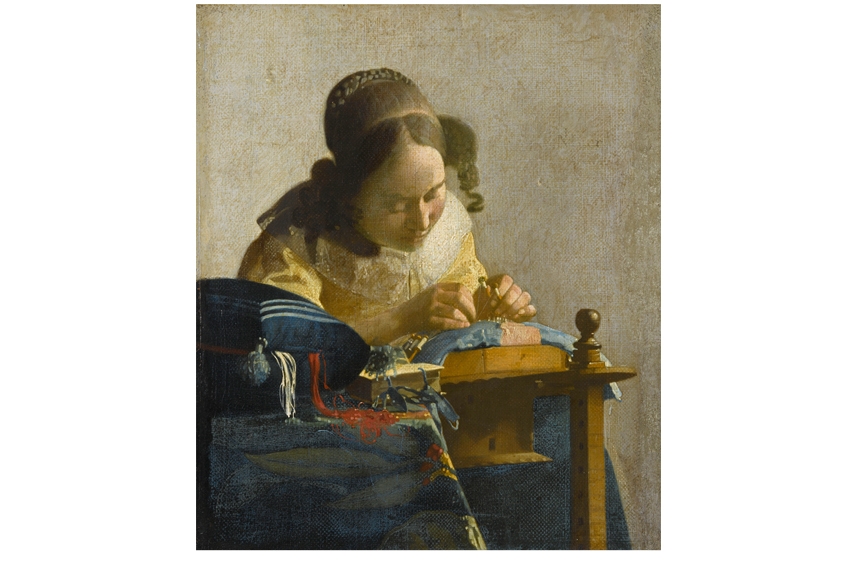Among exhibition organisers, hyperbole is clearly the order of the day. The crowds are going wild over Leonardo at the National Gallery, expecting an exhibition packed with paintings (though only nine are by the master), and now the Fitzwilliam is hauling them in with a show called Vermeer’s Women that contains just four paintings by Vermeer.
On the day I visited, the gallery was thronged, though the queues of which the management warned were thankfully not in evidence. I am frankly horrified by the volume of visitors to art galleries these days. I should perhaps be thankful that art is so popular, but the sheer numbers make the experience of viewing an exhibition increasingly disagreeable and unrewarding. You can hardly pause to study and consider without being elbowed or shouldered out the way. Does anyone stay at home in south-eastern England?
The Fitzwilliam’s show of 28 paintings from the Dutch Golden Age contains some old favourites such as de Hooch’s ‘Courtyard of a House in Delft’ as well as Vermeers from the National Gallery (‘A Young Woman Seated at a Virginal’) and the Royal Collection (‘The Music Lesson’). The other two Vermeer paintings are both small: ‘Young Woman Seated at a Virginal’, from a private collection in New York, is a late work, simplified and experimental, and less obviously interesting than its fellow exhibits. ‘The Lacemaker’, on loan from the Louvre for the first time in England, is the real reason to make the Cambridge pilgrimage. It is exquisitely beautiful, with a placid simplicity within its ordered complexity. This is a painting you want to gaze at and ponder quietly — an impossible hope amid the scrimmage of visitors who simply want to be able to say they’ve seen it.
It’s easier to view some of the other paintings, and I particularly liked the tiny mysterious candlelit scene by Godfried Schalken, the risqué Jan Steen next to it, and most especially the deeply enigmatic paintings of Jacobus Vrel (active c.1650–62), whose imagery subverts the cosy domestic narratives of the majority of paintings here. The catalogue calls him ‘probably the most elusive and mysterious of Dutch genre painters’, about whom next to nothing is known — even whether he was Dutch. He painted a fat woman tipped dangerously forward on a delicate chair looking through a dark window at a shadowy child. In another picture, the same bulky woman leans out of another window. An artist worth following up: the unexpected revelation of a somewhat unsatisfactory exhibition.
In lively contrast at Kettle’s Yard is Bridget Riley: colour, stripes, planes and curves, the swansong of the gallery’s retiring director, Michael Harrison. Both Vermeer and Riley are formal painters, dealing in very different ways with abstraction, and both offer highly sensuous visual experiences. After that, the comparison falters. The exhibition is a survey of Riley’s work over the past 30 years and contains some very beautiful and striking paintings. Chief among my favourites are ‘Red with Red 1’ (2007), which greets the visitor in splendour; then ‘Lux’, a fabulous new vertical stripe painting of slow-burn pinks punctuated with limpid greens and blues; ‘Lagoon 1’ (1997) is a complex delight, a problem picture in which Riley is working out how to return to the curve; and ‘Painting with Verticals 3’ (2006), a dance of curves which is full of subversive and unexpected shapes.
Meanwhile at Dulwich Picture Gallery is a highly enjoyable exhibition of Canadian painting, underlining the museum’s fondness for North American art. The star of the show is Tom Thomson (1877–1917), who died too young in mysterious circumstances but managed to produce a wealth of vivid landscape paintings before his canoe overturned in Algonquin Park. His paintings are in such evidence today because his friends, who subsequently formed the Group of Seven, were so shocked by his death that they determined to establish him in his rightful place — as one of Canada’s great artists. He is particularly acclaimed for his small luscious impasto studies done in front of the landscape, and these are the chief glory of this exhibition.
The show opens with a room of Thomson’s works, including his most famous image ‘The Jack Pine’, the tree near-silhouetted against horizontal strips of green and orange sky. The blockiness of the paint construction contrasts interestingly with two other paintings in this first room. In ‘The West Wind’ the shapes are handled more flowingly and there are echoes of the Nabis’ sense of cloisonné design, while in ‘The Pointers’ Thomson favours a pointillist approach. ‘Evening, Canoe Lake’ is a vibrant celebration of light and form, and it is this unforced response to the vividness of nature that is the key characteristic of this exhibition. It can be seen most emphatically in the second room, which is largely given over to small plein-air oil sketches on wooden panel that sing the praises of woods and water, spring and snow, sun and wind. Here’s the heart of the exhibition and however many good things may be found in the following rooms, it’s hard to beat the freshness and intensity of paint in Thomson’s oil studies.
Of the Seven, I particularly enjoyed the work of J.E.H. MacDonald and Franklin Carmichael, but all are worth looking at. After Dulwich, the exhibition will tour to Norway and the Netherlands, and is accompanied by a lavish hardback (Philip Wilson Publishers, £45) which, among other things, explores the relationship between these artists and the Scandinavian landscape tradition, also setting them in the context of European Expressionism. I would like to know more about their influence on English artists of the period, and what inspiration they drew from English art, given that two of the Seven were born in England and the Group’s work was first really appreciated in London, not Canada, at the British Empire exhibitions of 1924 and 1925. But the book is an informative and well illustrated introduction to the subject and makes a splendid memento of a company of artists unfairly forgotten in this country.






Comments